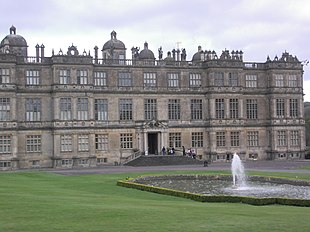 Global Information
Global InformationProdigy house information








Prodigy houses are large and showy English country houses built by courtiers and other wealthy families, either "noble palaces of an awesome scale"[1] or "proud, ambitious heaps"[2] according to taste. The prodigy houses stretch over the periods of Tudor, Elizabethan, and Jacobean architecture, though the term may be restricted to a core period of roughly 1570 to 1620.[3] Many of the grandest were built with a view to housing Elizabeth I and her large retinue as they made their annual royal progress around her realm. Many are therefore close to major roads, often in the English Midlands.
The term originates with the architectural historian Sir John Summerson, and has been generally adopted. He called them "...the most daring of all English buildings."[4] The houses fall within the broad style of Renaissance architecture, but represent a distinctive English take on the style, mainly reliant on books for their knowledge of developments on the Continent. Andrea Palladio (1508–1580) was already dead before the prodigy houses reached their peak, but it has conveniently been said that his more restrained classical style did not reach England until the work of Inigo Jones in the 1620s, and that as regards ornament, French and Flemish Northern Mannerist decoration was more influential than Italian.[5]
Elizabeth I travelled through southern England in annual summer "progresses", staying at the houses of wealthy courtiers,[6] on these trips she went as far north as Coventry, and planned a trip to Shrewsbury (where she planned on watching plays staged by Thomas Ashton), but this leg was cancelled because of illness.[7]
The hosts were expected to house the monarch in style, and provide sufficient accommodation for about 150 travelling members of the court, for whom temporary buildings might need to be erected.[8] Elizabeth was not slow to complain if she felt her accommodation had not been appropriate, and did so even about two of the largest prodigy houses, Theobalds House and Old Gorhambury House (the former destroyed, the latter ruined).[9]
Partly as a result of this imperative, but also general increasing wealth, there was an Elizabethan building boom, with large houses built in the most modern styles by courtiers, wealthy from acquired monastic estates, who wished to display their wealth and status.[10] A characteristic was the large area of glass – a new feature that superseded the need for easily defended external walls and announced the owners' wealth. Hardwick Hall, for example, was proverbially described as "Hardwick Hall, more glass than wall."[11] Many other smaller prodigy houses were built by businessmen and administrators, as well as long-established families of the peerage and gentry. The large Doddington Hall, Lincolnshire was built between 1593 and 1600 by Robert Smythson for Thomas Tailor, who was the recorder to the Bishop of Lincoln; "Tailor was a lawyer and therefore rich" says Simon Jenkins.[12]
Some recent uses of the term extend the meaning to describe large ostentatious houses in the United States of later periods, such as colonial mansions in Virginia, first so described by the American writer Cary Carson.[13]
- ^ Airs, 51, quoted
- ^ Ben Jonson, To Penshurst (1616) see below
- ^ as by Norwich, 670
- ^ Summerson (1980), 70
- ^ Summerson (1993), 50–54; Airs, 23–24, 37–38
- ^ Ridley, chapter 3
- ^ Parent, Independent School (2018-03-07). "Behind the Scenes: Shrewsbury School". Independent School Parent. Retrieved 2023-12-25.
- ^ Girouard, 111
- ^ Girouard, 109–112; Airs, 50
- ^ Summerson (1993), 58–59; Airs, 14–17, 50
- ^ Airs, 158
- ^ Jenkins, 433; Historic England. "Doddington Hall (1164612)". National Heritage List for England. Retrieved 1 August 2015.
- ^ Mooney, 2